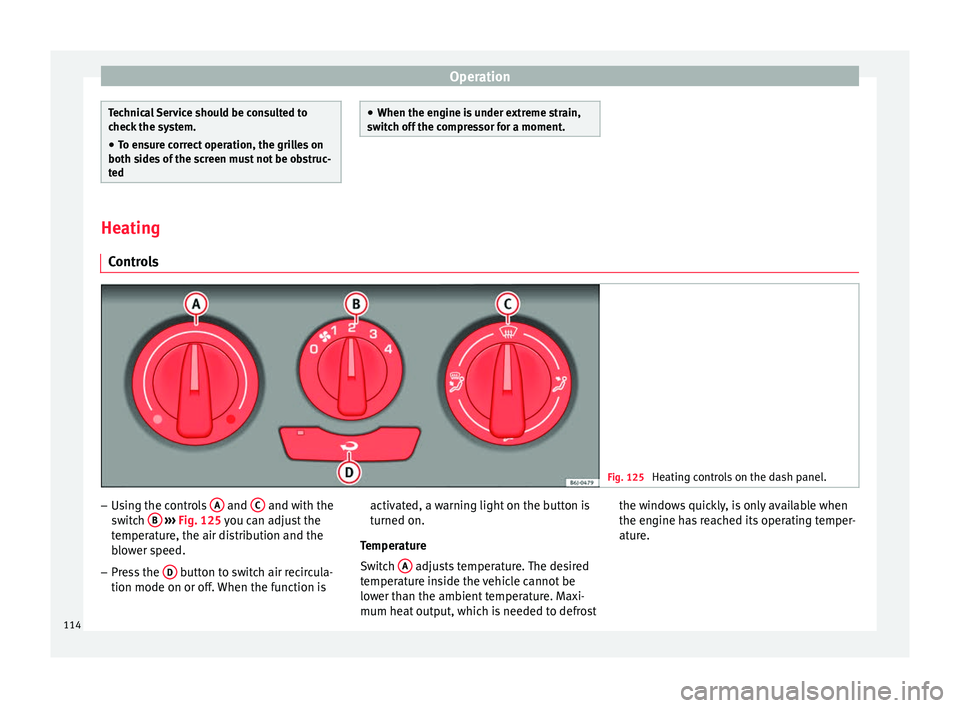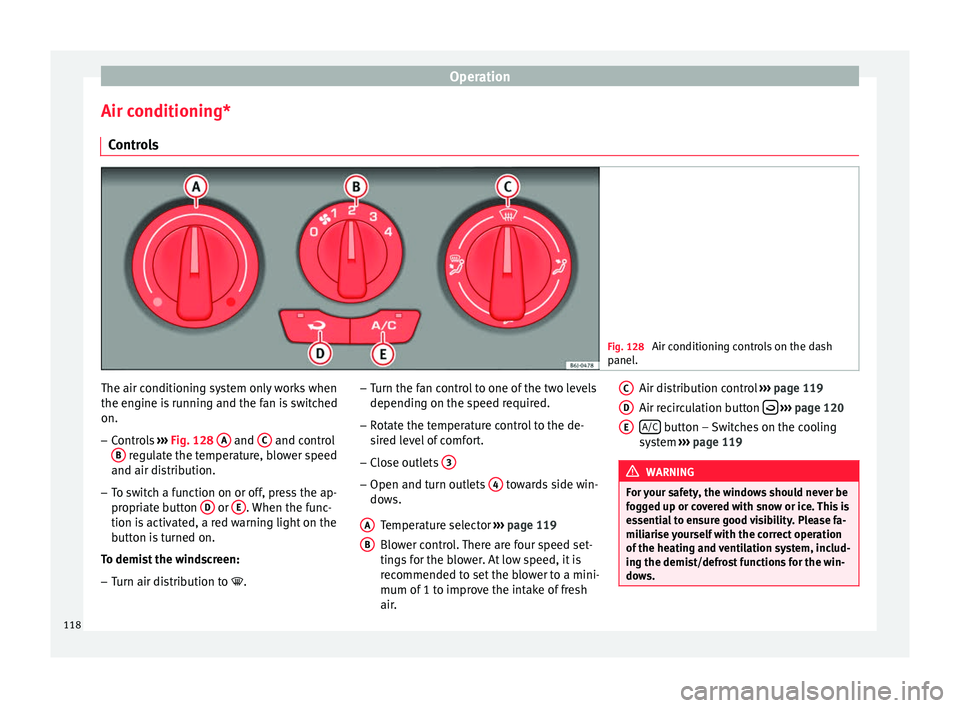2014 Seat Ibiza SC window
[x] Cancel search: windowPage 116 of 240

Operation
Technical Service should be consulted to
check the system.
● To ensure correct operation, the grilles on
both sides of the screen must not be obstruc-
ted ●
When the engine is under extreme strain,
switch off the compressor for a moment. Heating
Controls Fig. 125
Heating controls on the dash panel. –
Using the controls A and
C and with the
switch B
››› Fig. 125 you can adjust the
t emper
ature, the air distribution and the
blower speed.
– Press the D button to switch air recircula-
tion mode on or off. When the function is activated, a warning light on the button is
turned on.
Temperature
Switch A adjusts temperature. The desired
temperature inside the vehicle cannot be
lower than the ambient temperature. Maxi-
mum heat output, which is needed to defrost the windows quickly, is only available when
the engine has reached its operating temper-
ature.
114
Page 117 of 240

Air conditioning
Blower
The air flow can be set at four speeds with
switch B . The blower should always be set
at the lowest speed when driving slowly.
Air distribution
Control C for setting the flow of air in the re-
quired direction.
– Air distribution towards the windscreen
in or der t
o demist. For safety reasons, it is
not recommended to switch air recirculation
on.
– Air distribution to upper body.
– Air distribution to footwell
– Air distribution to the windscreen and
the footwell. Air recirculation mode
Air rec
irculation mode D on (a lamp lights
up in red) prevents strong odours from out-
side from entering the vehicle, for example
when passing through a tunnel or in a traffic
jam ››› .
When the outside temperature is low, air re-
circulation mode improves heating perform-
ance by heating air from the interior instead
of cold air from the outside. WARNING
● For your safety, the windows should never
be fogged up or covered with snow or ice.
This is essential to ensure good visibility.
Please familiarise yourself with the correct
operation of the heating and ventilation sys-
tem, including the demist/defrost functions
for the windows. ●
In air recirculation mode, no cold air from
the outside enters the vehicle interior. The
windows can quickly fog over if the heating is
switched off. Therefore, never leave the air re-
circulation mode switched on for a long time
(risk of accident). Note
● Please consider the general notes
››› page 113
. 115
Technical specifications
Advice
Operation
Safety
The essentials
Page 118 of 240

Operation
Vehicle ventilation or heating Fig. 126
Heating controls on the dash panel. Ventilating the vehicle interior
– Turn the temperature selector ››› Fig. 126
A anticlockwise.
– Turn blower switch B to any of the head
settings 1 -4.
– Set the airflow to the desired direction us-
ing air distribution control C .
– Open the relevant air outlets.
Interior heating
– Turn the temperature selector ››› Fig. 126
A clockwise to select the desired tempera-
ture.
– Turn blower switch B to any of the head
settings 1 -4. –
Set the airflow to the desired direction us-
ing air distribution control C .
– Open the relevant air outlets.
Defrosting the windscreen
– Turn the temperature selector ››› Fig. 126
A clockwise to reach the maximum tem-
perature.
– Turn the blower switch B to setting 4.
– Turn air distribution control to .
– Close outlet 3 .
– Open and turn outlet 4 towards the side
windows. Keeping the windscreen and the side
windows demisted
–
Turn the temperature selector ››› Fig. 126
A to the heating area.
– Turn blower switch B to any of the head
settings 2 -3.
– Turn air distribution control to .
– Clo
se outlets 3 –
Open and turn outlets 4 towards side win-
dows.
Once the windows are demisted and as a pre-
ventive measure, the control C can be set in
position , thus obtaining greater comfort
while preventing the windows from misting
again.
116
Page 119 of 240

Air conditioning
Heating
Maximum heat output, which is needed to
defrost the windows quickly, is only available
when the engine has reached its operating
temperature. Note
Remember that the temperature of the engine
coolant should be optimum to ensure that the heating system functions correctly (except in
vehicles fitted with additional heating*).
Air outlets
Fig. 127
Air vents Air distribution
CSymbolMain air output through out-
lets
1, 2
5
1, 2, 5
3, 4 Outlets
3 and
4 can be closed or opened
separately using the slats and the air flow di-
rected as required.
117
Technical specifications
Advice
Operation
Safety
The essentials
Page 120 of 240

Operation
Air conditioning* Controls Fig. 128
Air conditioning controls on the dash
panel. The air conditioning system only works when
the engine is running and the fan is switched
on.
–
Controls ››› Fig. 128 A and
C and control
B regulate the temperature, blower speed
and air distribution.
– To switch a function on or off, press the ap-
propriate button D or
E . When the func-
tion is activated, a red warning light on the
button is turned on.
To demist the windscreen: – Turn air distribution to .–
Turn the fan control to one of the two levels
depending on the speed required.
– Rotate the temperature control to the de-
sired level of comfort.
– Close outlets 3 –
Open and turn outlets 4 towards side win-
dows.
Temperature selector ››› page 119
Blower control. There are four speed set-
tings for the blower. At low speed, it is
recommended to set the blower to a mini-
mum of 1 to improve the intake of fresh
air.
A B Air distribution control
››› page 119
Air recirculation button
››› page 120
A/C button – Switches on the cooling
system ››› page 119 WARNING
For your safety, the windows should never be
fogged up or covered with snow or ice. This is
essential to ensure good visibility. Please fa-
miliarise yourself with the correct operation
of the heating and ventilation system, includ-
ing the demist/defrost functions for the win-
dows. C
D
E
118
Page 121 of 240

Air conditioning
Note
Please consider the general notes. Vehicle interior heating or cooling system
Fig. 129
Air conditioning controls on the dash
panel. Interior heating
– Turn off the cooling system using the
››› Fig. 129 A/C button (the button light
turns off).
– Turn the temperature selector A to set the
desired temperature inside the vehicle.
– Turn the blower switch to any of the set-
tings 1-4.
– Set the air distribution control C to the air
flow configuration desired: (towards the
windscreen), (towards the chest),
(towards the footwell) and
(towards the
windscreen and footwell areas).
Interior cooling
– Turn on the cooling system using the A/C button (the button light
should light up).
– Turn the t
emperature control switch until
the desired interior temperature is reached.
– Turn the blower switch to any of the set-
tings 1-4. –
Set the air distribution control to the air
flow configuration desired: (towards the
windscreen), (towards the chest),
(towards the footwell) and
(towards the
windscreen and footwell areas).
Heating
Maximum heat output, which is needed to
defrost the windows quickly, is only available
when the engine has reached its operating
temperature. »
119
Technical specifications
Advice
Operation
Safety
The essentials
Page 122 of 240

Operation
Coolant system
When the air conditioning is switched on, the
temperature and the air humidity go down.
This way, if the outside humidity is extreme,
the air conditioning prevents the misting of
the windows and therefore, comfort is im-
proved.
If the air conditioning does not work, this
may be due to the following reasons:
● The engine is stationary.
● The fan blower is switched off.
● The outside temperature is lower than ap-
proximately +3 °C (+37 °F).
● The air conditioning system compressor
has been temporarily switched off because of
an increased engine coolant temperature.
● The air conditioner fuse is faulty.
● Another fault in the vehicle. Have the air
conditioning checked by a specialised work-
shop.
Air recirculation Air recirculation mode on
›››
Fig. 129 (a
lamp lights up on the button) prevents strong
odours or contaminated air from the outside air from entering in the vehicle, for example
when passing through a tunnel or in a traffic
jam.
When the outside temperature is low, air re-
circulation mode improves heating perform-
ance by heating air from the interior instead
of cold air from the outside.
When the outside temperature is high, air re-
circulation mode improves cooling perform-
ance by cooling air from the interior instead
of warm air from outside.
For safety reasons, the air recirculation
should not be switched on
when the air dis-
tribution control is set to the windscreen set-
ting . WARNING
In air recirculation mode, no cold air from the
outside enters the vehicle interior. If the air
conditioner is switched off, the windows can
quickly mist over. Therefore, never leave the
air recirculation mode switched on for a long
time (risk of accident). Note
● When engaging reverse gear, the air recir-
culation is connected automatically to pre-
vent the entrance of exhaust gases in the ve-
hicle on travelling backwards. The control
lamp on the button does not light up.
● If the temperature control is turned to the
coldest setting (blue point) and the A/C but- ton is on, the “Air recirculation” function is
automatically activated in order to cool the
vehicle faster using less energy, and its func-
tion control lamp will light up.
● If the function is not deactivated by press-
ing the button, it will deactivate after approx-
imately 20 minutes. Economic use of the air conditioning
When the air conditioning is switched on, the
compressor consumes engine power and has
influence on fuel consumption. Consider the
following points in order to have the system
operating in the minimum possible time.
● If the vehicle interior has overheated due to
an excessive solar radiation, it is best to
open the windows or doors to allow the hot
air to escape.
● While in motion, the air conditioning
should not be switched on if the windows or
the sunroof* are open.
120
Page 123 of 240

Air conditioning
Climatronic* Controls Fig. 130
Climatronic controls on the dash panel. Read the additional information carefully
››› page 21
The air conditioner only works when the en-
gine is running and the blower is on.
The functions will be switched on when its
buttons are pressed, turning on the air condi-
tioner if it was switched off, with the excep-
tion of button 17 (recirculation) When the
function is activated, a symbol is displayed
on the screen. Press the button again to
switch off the function.
To switch off the climatronic, press button 9until the segments in column
1 go off. After1 second has passed, press the button again
to switch off the display. WARNING
For your safety, the windows should never be
fogged up or covered with snow or ice. This is
essential to ensure good visibility. Please fa-
miliarise yourself with the correct operation
of the heating and ventilation system, includ-
ing the demist/defrost functions for the win-
dows. Note
Please consider the general notes. Automatic mode
In this mode, air temperature, air flow and
distribution are automatically adjusted so
that a comfortable temperature is attained as
quickly as possible, and then maintained.
Switching on automatic mode
– Press the AUTO button. It displays the indi-
cation ››› Fig. 130 3 .
– Press keys ››› Fig. 130 10 and
11 to adjust
the desired temperature inside the vehicle.
We recommend +22 °C (+72 °F). »
121Technical specifications
Advice
Operation
Safety
The essentials